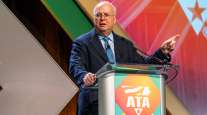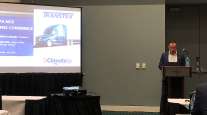EPA Touts Science, Data Gathering as Basis for Phase 2 Rule on GHG

PHILADELPHIA — Chris Grundler, the Environmental Protection Agency official behind the Phase 2 greenhouse-gas proposal, is passionate about reducing vehicle emissions but quick to point out his commitment to data, evidence and engineering as the foundation for writing regulations.
As director of EPA’s Office of Transportation and Air Quality, or OTAQ, Grundler has 40 people working on Phase 2.
“We’re gathering data, testing, modeling emissions and visiting firms. It’s very rigorous,” Grundler said in an interview after his public address here Oct. 19.
COMPLETE COVERAGE: MCE 2015
The current activity for his staff is reviewing more than 140,000 comments that were filed by the Oct. 1 deadline. Grundler said all of the comments are read and that his staff must produce a response document.
The final rule on heavy- and medium-duty truck emissions is scheduled for publication by EPA and the National Highway Traffic Safety Administration in May, and he could not comment on what will be in it, but he said comments rich in technical data have changed final rules in the past from what was initially proposed.
“We incorporate what we learn and try to make a rule more like how the real world works. Our goal is to make it better,” he said.
While EPA and NHTSA are writing a national rule, the California Air Resources Board plays a critical role in the process, he said, because Congress has given California special consideration for regulating its air quality.
“We talk daily,” Grundler said of the interactions between his staff and CARB, “and I meet with them every two weeks.”
He added, “California is facing challenging air quality problems, and we’re doing all we can to maintain a national approach,”
CARB said in its comments to EPA that it would like to lower the output of carbon dioxide and nitrogen oxides simultaneously. Truck and engine makers have said lowering both at the same time is extremely difficult at best.
Shortly after Grundler finished his remarks, Daimler Trucks North American held a press event, and its executives spoke about the Phase 2 rule, among other subjects.
CEO Martin Daum explicitly implored EPA and CARB not to alter the current NOx standard as part of the greenhouse-gas reduction rule.
“NOx and CO2 are inextricably intertwined in engines,” said Sean Waters, DTNA’s director of compliance and regulatory affairs.
Minimizing one gas tends to produce more of the other, Waters explained, but he said the charm of pursuing fuel efficiency is that less fuel is burned, and that leads to lower emissions overall.
Waters gave EPA credit, saying that staff is “very data driven on costs and benefits. . . . They approach issues as fact-based problems, not an emotional issue.”
Grundler said of the CO2-NOx issue that EPA has gone after both at the same time on cars, but not trucks.
“We decided early on to be conscious of NOx” in Phase 2 for trucks, but in 2012, when EPA began working on it, “there was not enough information to evaluate” doing both.
Grundler said he is eager to review CO2-NOx work being done by the Southwest Research Institute, and he will evaluate it next year, if the report is published when scheduled.
The current GHG proposal sets up an emissions schedule through 2027. Grundler said he likes long-term structure, in part because truck and engine makers have endorsed it.
Waters said DTNA backs the proposed 2027 schedule and opposes what is called Alternative 4, an acceleration of the final standards to 2024, and also is against the idea of a mid-course review.
Kenworth Truck Co. General Manager Preston Feight said during a press conference the day before Grundler’s remarks that meeting environmental standards is a significant engineering challenge but also an opportunity.
“If you look at the last couple of [regulatory] cycles, we’ve gained in market share,” said Feight, who was Kenworth’s chief engineer earlier in his career.
“We are working with the government to make a proper rule achievable,” he said.
Staff Reporter David Elfin contributed to this story.




